Jemila MacEwan is an interdisciplinary artist based in New York. MacEwan is known for her intimately interwoven earthworks, sculptures and performances that build mythological narratives around meteorites, volcanoes, and glaciers. These stories engage with the emotional complexity of being human within the Holocene extinction. MacEwan is a current recipient of The Marten Bequest Travelling Scholarship 2020. They received a Master of Contemporary Art at the University of Melbourne, Australia. They have performed and exhibited extensively internationally including; ARoS Museum (Denmark), The Australian Consulate-General (NYC), Pioneer Works (NYC), Victori +MO (NYC), The Elizabeth Foundation for the Arts (NYC), BRIC Biennial III (NYC), Skaftfell Center for Visual Art (Iceland) and The Castlemaine State Festival (Australia). They have been invited to attend many residencies notably; BANFF Center for Arts and Creativity (Canada), NARS Foundation (NYC), Ox-Bow School of Painting (MI), Sculpture Space (NY), and is the founder of the performance process residency Land Falls (NY). MacEwan has been generously supported by the Australia Council for the Arts, Café Royal Cultural Foundation, the Dame Joan Sutherland Fund, the Ian Potter Cultural Council and the Graduate Women of Victoria.
Published on May 6th, 2021. Artist responses collected in months previous.
What hurdles have you overcome this year and how have they affected your art practice?
Like most people I know pandemic caused a lot of residency and travel plans to be cancelled or postponed. I received a large grant to make a new work and another scholarship grant for travel study, it made a huge difference to my confidence in my work but both have been postponed indefinitely. I found it really hard to work out where to put my energy early on in the lockdown in New York so I started a conversation series called 'Rewilding' on Instagram, where I talked with other artists about how they would define the spiritual dimensions of their work as as artists. I'd like to do a second season but I got quite busy. I was really fortunate to secure a studio space on Governors Island for the summer through NYU Virtual Volcano Lab where I am able to conduct a whole lot of experiments growing mycelium based sculptures.
How has your art practice been affected by the pandemic?
The pandemic has added so much chaos and extra challenge to the day to day as well as throwing long term plans into disarray. Having people help me with the physical nature of my work is difficult with social distancing enforced. Wearing masks affected me in ways I didn't expect as well. I found that the social distancing and the mask wearing were making me emotionally disengage from those around me. The physical and abstract boundaries that we're having to adhere to prevent so much of the more nuanced intimate forms of connection that play a huge role in empathy. The work I make and the ideas I engage with have not changed as a result of the pandemic, I've been making work about vulnerability, connection and touch for a long time, so if anything it has given me a chance to reflect on these past work through the lens of now.
What support systems have you put in place to help keep your practice thriving amidst these unforeseeable circumstances?
A lot of my work is about the complex emotions humans must contend with in a world that is in constant change, so in a way I've always been bracing myself for whatever mystery comes next. While making plans as an artist is necessary the circumstances of the future have always been unforeseeable and being an artist the way I've experienced has always been about adaptability. Also hope. The hope and resilience in the face of failure, rejection, compromise, lack of resources are just part of the stamina that artists need so they can endure. As a result I'm always building support structures - people, interests, methods of creation, access to spaces - and those support structures become invaluable at times like these. Though I also want to say that for me every year feels like it warrants the term 'unprecedented times' simply because we are always confronting new levels of unknowable harm to our planet and its inhabitants.
What methods do you employ to stay resilient in your art practice? What tips would you recommend to other artists who find staying resilient difficult?
The environment of art production and distribution does not have the resilience, sustainability and mental health of artists in mind. One of the ways an artist can become easily depressed, apathetic or miserable is to subscribe to the neo-liberal modes of competitive free-market capitalism. I've never met an artist who subscribed to this attitude who wasn't isolated, paranoid, bitter and aggressive. If you think about yourself as a tree, and your art as the fruit that comes from that tree, it is clear that you can't simply keep producing delicious fruit all year round, you need time to recover after creating, recognise when you are in the 'winter' of your process, you need to be in partnership with other trees and pollinators. You need to breath and receive sunlight. You need to understand your own rhythm and cycle of creation unique to you. Art is not a competition and at it's best it should be there for you to make sense of a senseless world. Art is made stronger when you support your peers and their work and they support you. Abandon any attachment to the importance of superficial success in favor of making art because it keeps you alive.
What have you learned about yourself as an artist this year?
I have learned that the role I play in my own work is much smaller than I suspected. For instance this summer I have been working on a new monumental sculpture work entitled 'Dead Gods' where I resurrect giant prehistoric fungi by growing them out of their contemporary mycelial ancestors. In this case I have been growing them out of oyster mushrooms and reishi. I'm right in the middle of this work right now and I have come to realize that my role is really just as a support to the mycelium. The mycelium have made all the creative calls in this project - from conception to process. I've been humbled to try and learn from their own unique subjectivity in my supporting role as artist/collaborator. Through this I have been reflecting on much of my past work and how I as and artist I am always there to be the student of entities far greater than me.
What hurdles have you overcome this year and how have they affected your art practice?
Like most people I know pandemic caused a lot of residency and travel plans to be cancelled or postponed. I received a large grant to make a new work and another scholarship grant for travel study, it made a huge difference to my confidence in my work but both have been postponed indefinitely. I found it really hard to work out where to put my energy early on in the lockdown in New York so I started a conversation series called 'Rewilding' on Instagram, where I talked with other artists about how they would define the spiritual dimensions of their work as as artists. I'd like to do a second season but I got quite busy. I was really fortunate to secure a studio space on Governors Island for the summer through NYU Virtual Volcano Lab where I am able to conduct a whole lot of experiments growing mycelium based sculptures.
How has your art practice been affected by the pandemic?
The pandemic has added so much chaos and extra challenge to the day to day as well as throwing long term plans into disarray. Having people help me with the physical nature of my work is difficult with social distancing enforced. Wearing masks affected me in ways I didn't expect as well. I found that the social distancing and the mask wearing were making me emotionally disengage from those around me. The physical and abstract boundaries that we're having to adhere to prevent so much of the more nuanced intimate forms of connection that play a huge role in empathy. The work I make and the ideas I engage with have not changed as a result of the pandemic, I've been making work about vulnerability, connection and touch for a long time, so if anything it has given me a chance to reflect on these past work through the lens of now.
What support systems have you put in place to help keep your practice thriving amidst these unforeseeable circumstances?
A lot of my work is about the complex emotions humans must contend with in a world that is in constant change, so in a way I've always been bracing myself for whatever mystery comes next. While making plans as an artist is necessary the circumstances of the future have always been unforeseeable and being an artist the way I've experienced has always been about adaptability. Also hope. The hope and resilience in the face of failure, rejection, compromise, lack of resources are just part of the stamina that artists need so they can endure. As a result I'm always building support structures - people, interests, methods of creation, access to spaces - and those support structures become invaluable at times like these. Though I also want to say that for me every year feels like it warrants the term 'unprecedented times' simply because we are always confronting new levels of unknowable harm to our planet and its inhabitants.
What methods do you employ to stay resilient in your art practice? What tips would you recommend to other artists who find staying resilient difficult?
The environment of art production and distribution does not have the resilience, sustainability and mental health of artists in mind. One of the ways an artist can become easily depressed, apathetic or miserable is to subscribe to the neo-liberal modes of competitive free-market capitalism. I've never met an artist who subscribed to this attitude who wasn't isolated, paranoid, bitter and aggressive. If you think about yourself as a tree, and your art as the fruit that comes from that tree, it is clear that you can't simply keep producing delicious fruit all year round, you need time to recover after creating, recognise when you are in the 'winter' of your process, you need to be in partnership with other trees and pollinators. You need to breath and receive sunlight. You need to understand your own rhythm and cycle of creation unique to you. Art is not a competition and at it's best it should be there for you to make sense of a senseless world. Art is made stronger when you support your peers and their work and they support you. Abandon any attachment to the importance of superficial success in favor of making art because it keeps you alive.
What have you learned about yourself as an artist this year?
I have learned that the role I play in my own work is much smaller than I suspected. For instance this summer I have been working on a new monumental sculpture work entitled 'Dead Gods' where I resurrect giant prehistoric fungi by growing them out of their contemporary mycelial ancestors. In this case I have been growing them out of oyster mushrooms and reishi. I'm right in the middle of this work right now and I have come to realize that my role is really just as a support to the mycelium. The mycelium have made all the creative calls in this project - from conception to process. I've been humbled to try and learn from their own unique subjectivity in my supporting role as artist/collaborator. Through this I have been reflecting on much of my past work and how I as and artist I am always there to be the student of entities far greater than me.
Find Jemila MacEwan on Instagram






